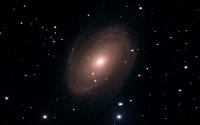Strongly Celestial Looking outward; looking backward in time... |
 |
||
M63 - Sunflower Galaxy History / Fun Facts M63, known as the Sunflower due to its apperance, was first discovered by Messier's assistant Pierre Mechain on June 14, 1779. It was one of the first galaxies identified as having a spiral structure by Lord Rosse in the mid-1800's. It's distance from Earth is of some debate, but it is most commonly believed to be 37M lightyears away. It isapproximately 90,000 lightyear in diameter, giving it an apparent size of 12'.6 x 7'.2 in the sky. It is a part of the M51 group of interacting galaxies. At the center of this galaxy is believed to be a super massive black hole, estamiated to be 30 million solar masses. Although the spiral structure appears regular at first glance, detailed studies have shown a pronounced asymmetry in the structure. Further, there are large portions of active star forming regions along the spirals. And the arms themselves extend unusually far from the galactic core. These facts all add up to strong evidence that M63 has fairly recently interacted with and "absorbed" a neighboring satellite galaxy. |
|||
Date Taken: 1/15/2014 Equipment: Processing / Comments |
||